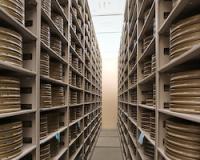
Ariel West
The UCLA Film & Television Archive is pleased to welcome filmmaker and researcher Ariel West as its 2025 artist-in-residence. An Angeleno currently based in Queens, New York, West’s work in time-based media explores infrastructure, power and history through archival research, memory and oral history.
West will survey the intertwined histories of oil, media and urban development through the Archive’s collections, reexamining the city’s past while envisioning a post-oil future. Her proposed film, Petroleum Archive, inspired by Stephanie LeMenager’s concept of the same name, will blend archival footage with newly captured imagery, including preservation processes and driving sequences through Los Angeles.
"Growing up in Los Angeles, I saw pumpjacks and heard stories of its oil-covered past. Yet, I hadn’t realized how deeply oil shaped the city — becoming the world’s largest producer in the 1920s and peaking in 1969. After decades of extraction, L.A. finally passed a 2023 ordinance banning new drilling, thanks to tireless advocacy,” West shared.
Drawing from the Archive’s Hearst Metrotone News and KTLA Newsfilm collections, West will explore oil’s imprint on the city’s identity, from industry and workers to freeways and environmental crises. “We’re eager to see how Ariel uncovers new insights into the city’s oil production legacy using these two rich sources of Los Angeles history,” said Maya Montañez Smukler, head of the Archive Research and Study Center at the Archive, a department of UCLA Library.
West currently serves as the archival researcher for Cynthia Madansky’s Index:trace and recently produced and edited the film Fattoush in collaboration with director Sophia Stamatopoulou-Robbins. A Bard College alumna, West was a 2021 Hannah Arendt Scholar and recipient of the Jamie Lubar ’72 Research Prize and the Naomi Bellinson Feldman ’53 Award. Last fall, she extended her thesis installation “Petro-Stained City,” which she began in 2022, into a 12-week Learning and Mending Series at Metabolic Studios in Los Angeles. These projects examined the role of narrative and visibility in Los Angeles’ historical and contemporary oil economy, the city’s petroculture, and its unevenly distributed environmental and public health effects.
“During my time as artist-in-residence, I aim to unravel how oil narratives were constructed and shaped Los Angeles through archived news segments and outtakes. In my research into the KTLA collection, I have already uncovered controversies that were previously unknown to me, like oil company land grabs. These overlooked moments make me incredibly grateful to immerse myself in the UCLA Film & Television Archive’s holdings," said West.
About the Artist-in-Residence Program
The UCLA Film & Television Archive’s Artist-in-Residence Program will host an emerging artist for two weeks on-site at the Archive’s locations in Santa Clarita at the Packard Humanities Institute and in Westwood on the UCLA campus to activate the Archive’s collection in their artistic practice. The 2025 artist-in-residence will work exclusively with one or a combination of three specific collections: the Hearst Metrotone News Collection, In the Life LGBTQ+ Collection, and KTLA Newsfilm Collection. The program will give the artist the time and support necessary to access and work with these unique collections, creating a project that will reach new audiences and connect with Los Angeles’ cultural community. The Hearst Metrotone News Collection is available on newsreels.net as part of a joint project with The Packard Humanities Institute (PHI) to preserve and make accessible millions of feet of newsreels to the public.






 Mobile Navigation
Mobile Navigation

